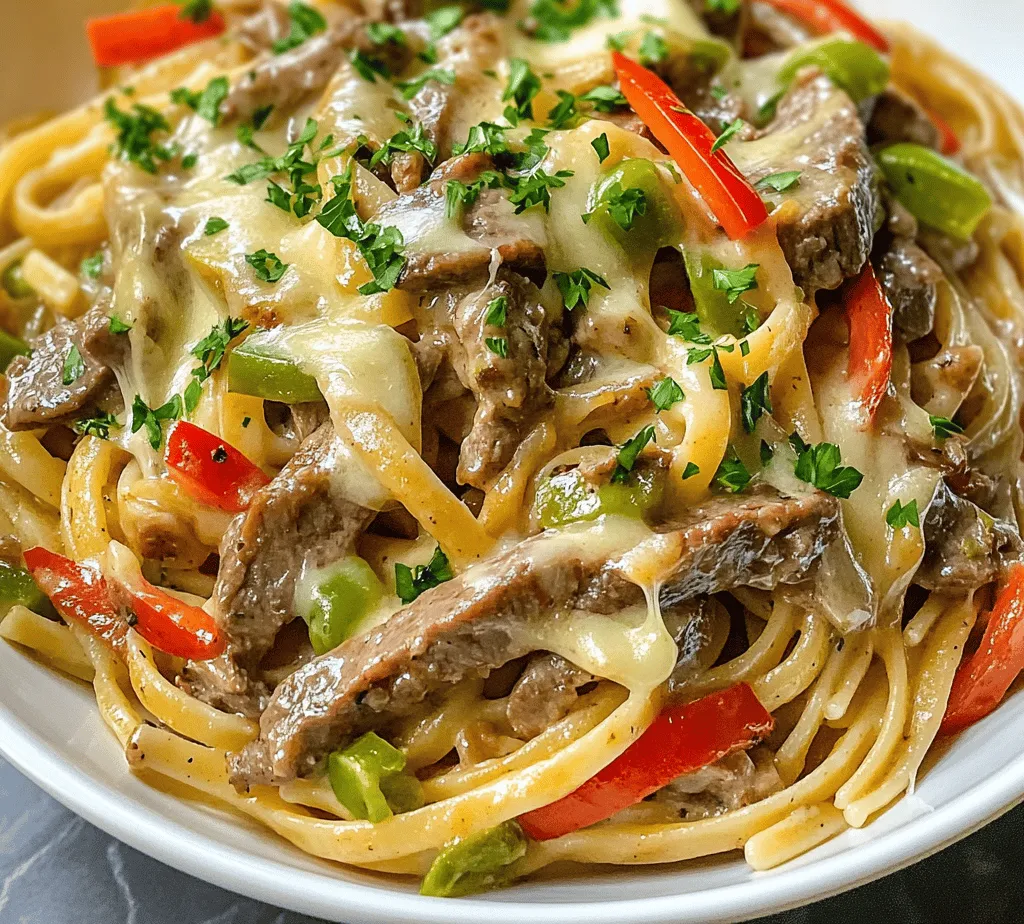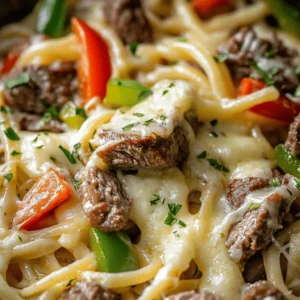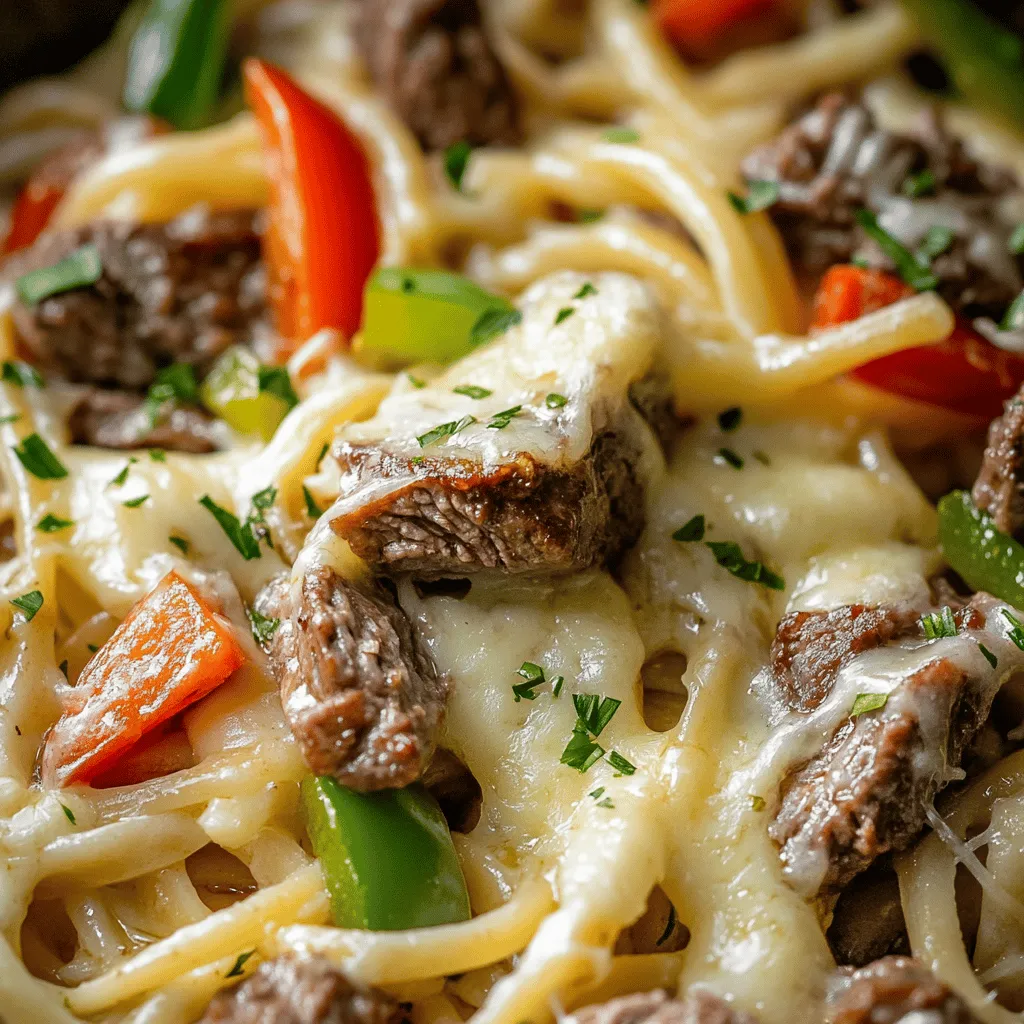Introduction
If you’re a fan of comforting, hearty meals that combine robust flavors and satisfying textures, then the Delicious Philly Cheese Steak Pasta Recipe is sure to become a favorite in your kitchen. This dish takes inspiration from the iconic Philly cheesesteak sandwich, a beloved staple of Philadelphia cuisine known for its thinly sliced beef, melted cheese, and sautéed onions and peppers. By transforming these classic components into a pasta dish, you not only pay homage to a culinary tradition but also create a practical and delightful meal perfect for weeknight dinners.
Combining the savory essence of a cheesesteak with the versatility of pasta, this recipe celebrates the marriage of flavors and textures that make both dishes so popular. The creamy sauce envelops each strand of pasta, while the beef and vegetables add depth and character. Whether you’re feeding a family or hosting friends for dinner, this Philly cheese steak pasta is straightforward to prepare and sure to impress.
The Allure of Philly Cheese Steak Pasta
The origins of the Philly cheesesteak date back to the 1930s in Philadelphia, where it was created by Pat Olivieri, a hot dog vendor who decided to grill some beef on his griddle. The sandwich quickly gained popularity, with locals and visitors alike flocking to savor the juicy beef topped with melted cheese, often accompanied by sautéed onions and peppers. Today, this sandwich has become a symbol of Philadelphia’s culinary landscape, adored by many and replicated in various forms across the country.
Incorporating pasta into the cheesesteak tradition is a clever twist that adds a new dimension to the classic flavors. The noodles serve as a perfect vessel for the rich and savory sauce, allowing each bite to deliver a satisfying combination of protein, carbs, and that signature cheesesteak taste. This fusion of pasta and a beloved sandwich not only enhances the dish’s texture but also makes it a hearty meal that can be prepared in under an hour, making it ideal for busy weeknights.
The benefits of integrating pasta into classic recipes like the cheesesteak are numerous. Firstly, pasta provides a neutral base that can absorb flavors, ensuring every mouthful is filled with the delicious essence of the beef, cheese, and seasonings. Secondly, pasta dishes tend to be crowd-pleasers, as they appeal to a wide range of tastes and preferences. Finally, this recipe allows for creativity; you can easily customize ingredients and seasonings to suit your palate or dietary needs.
Ingredients Breakdown
To create a truly delicious Philly cheese steak pasta, it’s essential to choose high-quality ingredients that will enhance the flavor of the dish. Let’s break down the key components:
1. Pasta (Linguine or Fettuccine): The choice of pasta can significantly impact the dish’s overall experience. Linguine or fettuccine are excellent options because their flat shapes allow for a better sauce cling, ensuring each strand is coated in the rich, creamy mixture.
2. Beef Sirloin: Selecting the right cut of beef is crucial for achieving the perfect flavor and tenderness. Sirloin is ideal for this recipe because it is lean yet flavorful, making it a great choice for quick cooking. Thinly sliced beef will cook quickly and remain tender, which mimics the texture of traditional cheesesteak fillings.
3. Vegetables (Onions and Bell Peppers): Sautéed onions and bell peppers are quintessential to the cheesesteak experience. They contribute sweetness, texture, and a burst of flavor that complements the beef beautifully. These vegetables not only enhance the dish but also add nutritional value.
4. Garlic: Fresh garlic is a must for elevating the overall flavor profile. It adds depth and aroma, creating a fragrant base for the dish. Sautéing garlic with the vegetables releases its natural oils, resulting in a wonderfully aromatic dish.
5. Beef Broth and Heavy Cream: The combination of beef broth and heavy cream creates a rich, velvety sauce that envelops the pasta and meat. Beef broth enhances the savory notes, while heavy cream adds a luxurious creaminess that ties all the flavors together.
6. Provolone Cheese: A hallmark of the cheesesteak, provolone cheese provides that iconic gooey, melty texture. It’s essential to use good-quality provolone to ensure it melts well and melds into the sauce.
7. Worcestershire Sauce and Italian Seasoning: These ingredients bring layers of flavor complexity to the dish. Worcestershire sauce adds a savory umami touch, while Italian seasoning enhances the overall profile with its blend of herbs.
Step-by-Step Cooking Instructions
Now that we’ve covered the essential ingredients, let’s dive into the cooking process. Follow these detailed steps to ensure optimal results for your Philly cheese steak pasta.
Cooking the Pasta
1. Boil Water: Start by bringing a large pot of salted water to a rolling boil. The salt is crucial as it enhances the pasta’s flavor.
2. Add Pasta: Once the water is boiling, add your linguine or fettuccine to the pot. Stir gently to prevent the noodles from sticking together.
3. Achieve Al Dente: Cook the pasta according to package directions until it is al dente, which means it should be tender but still have a slight bite to it. This typically takes around 8-10 minutes. Remember, the pasta will continue to cook slightly once added to the sauce.
4. Reserve Pasta Water: Before draining the pasta, reserve about a cup of the pasta cooking water. This starchy water can be added to the sauce later for a creamier texture.
5. Drain and Set Aside: After cooking, drain the pasta and set it aside, allowing it to cool slightly while you prepare the rest of the dish.
Sautéing the Beef
1. Prepare the Beef: While the pasta is cooking, thinly slice the beef sirloin against the grain. This helps to ensure tenderness.
2. Heat the Pan: In a large skillet or sauté pan, heat a tablespoon of oil over medium-high heat. You want the pan to be hot enough to sear the beef quickly, giving it a nice brown crust.
3. Sauté the Beef: Add the sliced beef to the hot skillet in a single layer, being careful not to overcrowd the pan. This allows for even browning. Season the beef lightly with salt and pepper.
4. Cook Until Browned: Sear the beef for about 2-3 minutes on one side before flipping it over. Continue cooking until the beef is browned but not fully cooked through, as it will continue to cook in the sauce.
5. Remove and Set Aside: Once browned, remove the beef from the pan and set it aside on a plate. This step is important to prevent overcooking.
6. Sauté the Vegetables: In the same skillet, add a bit more oil if necessary, then toss in the sliced onions and bell peppers. Sauté for about 4-5 minutes until they are softened and slightly caramelized.
7. Add Garlic: Add minced garlic to the vegetables and sauté for an additional minute until fragrant.
This detailed breakdown of the initial cooking steps will set the stage for the rich, creamy sauce that will bring all the elements of the dish together beautifully. In the next section, we will continue with the sauce preparation and final assembly of the Delicious Philly Cheese Steak Pasta.

Cooking the Vegetables
To achieve the perfect texture and flavor for your Philly Cheese Steak Pasta, it’s essential to cook the vegetables correctly. Start by heating a tablespoon of olive oil in a large skillet over medium heat. Once the oil is shimmering, add your sliced bell peppers and onions.
Cook them for about 5-7 minutes until they are softened but still have a bit of crunch. The goal is to achieve a tender texture without losing all the vibrant color. Stir occasionally to ensure even cooking. If you prefer your vegetables to be more caramelized and flavorful, you can reduce the heat to medium-low and let them cook a little longer, stirring occasionally. This will bring out their natural sweetness, enhancing the overall flavor of the dish.
Making the Sauce
The sauce is the heart of your Philly Cheese Steak Pasta, and getting the right consistency and flavor balance is key. After the vegetables are perfectly cooked, push them to the side of the skillet. In the cleared space, add minced garlic and sauté for about 30 seconds until fragrant. Then, mix in a tablespoon of flour to create a roux, stirring constantly for about 1 minute. This will help thicken your sauce.
Next, gradually pour in 1 cup of beef broth while continuously whisking. This will prevent lumps from forming and ensure a smooth sauce. Allow the mixture to come to a simmer, letting it thicken slightly before adding 1 cup of heavy cream. Stir well to combine all the ingredients. Season the sauce with salt, pepper, and a dash of Worcestershire sauce for an added depth of flavor. Let it simmer for another few minutes until the sauce reaches your desired consistency.
Combining Ingredients
Once the sauce is ready, it’s time to combine all the ingredients for a harmonious blend of flavors. Add your cooked pasta to the skillet, followed by the sautéed vegetables. Using a spatula, gently fold the pasta into the sauce, ensuring that every piece is coated in the creamy mixture. This thorough mixing is vital for flavor distribution, allowing the sauce to cling to the pasta and all the ingredients to meld together beautifully.
If the sauce appears too thick, you can add a splash of reserved pasta water to loosen it up. This will also help the sauce adhere better to the pasta, enhancing the overall texture of the dish.
Incorporating Cheese
No Philly Cheese Steak Pasta is complete without cheese. For the ultimate cheesy experience, use a combination of provolone and mozzarella or cheddar. Add the cheese to the skillet after combining the pasta and sauce. Stir gently until the cheese melts evenly throughout the dish. If you want a slightly crispy top, you can transfer the mixture to a baking dish and broil it in the oven for a few minutes until golden brown and bubbly.
Serving Suggestions
Presentation plays an important role in the enjoyment of any dish. For serving your Philly Cheese Steak Pasta, consider garnishing it with freshly chopped parsley or chives for a pop of color. A sprinkle of additional cheese on top can also enhance its visual appeal.
For a complete meal, serve it alongside a simple green salad or garlic bread. This dish is best enjoyed hot, but if you have leftovers, they can be stored in an airtight container in the refrigerator for up to three days.
Nutritional Information
When it comes to enjoying a hearty dish like Philly Cheese Steak Pasta, it’s essential to be aware of its nutritional content. Here’s a breakdown of the estimated nutritional information per serving (based on a serving size of about 1.5 cups):
– Calories: Approximately 600 kcal
– Protein: 30g
– Fat: 35g
– Carbohydrates: 45g
The key ingredients in this dish bring numerous health benefits. For example, bell peppers are rich in vitamins A and C, while onions offer anti-inflammatory properties. Lean cuts of steak provide a good source of protein, essential for muscle repair and growth.
If you’re looking for dietary modifications, consider using gluten-free pasta options to cater to gluten sensitivities. This way, you can enjoy the same delicious flavors without compromising on dietary needs.
Cooking Tips for Perfect Philly Cheese Steak Pasta
To elevate your Philly Cheese Steak Pasta, consider the following tips for optimal results:
– Ingredient Quality: Always choose high-quality, fresh ingredients. Opt for USDA choice or higher cuts of beef for a more flavorful steak. Fresh vegetables will enhance the dish significantly.
– Seasoning Techniques: Don’t be afraid to experiment with seasoning. Adding smoked paprika or Italian seasoning can enhance the flavor profile. Taste as you go along to ensure the seasoning is balanced.
– Avoid Common Pitfalls: One common mistake is overcooking the pasta. Make sure to cook it al dente, as it will continue to cook when mixed with the sauce. Additionally, avoid adding too much salt initially, as the cheese and broth will contribute sodium to the dish.
Variations and Customizations
One of the beauties of Philly Cheese Steak Pasta is its versatility. Here are some ideas for customizing the recipe to suit your preferences:
– Ingredient Substitutions: If you’re not a fan of provolone cheese, try using gouda or pepper jack for a different flavor. You can also substitute the beef with grilled chicken or sautéed mushrooms for a vegetarian option.
– Adding Vegetables: Incorporate additional vegetables such as sautéed mushrooms, fresh spinach, or zucchini to boost the nutritional content and add more texture.
– Spicy or Savory Options: For those who enjoy a kick, add sliced jalapeños or a pinch of red pepper flakes to the sauce. Alternatively, a splash of soy sauce can enhance the umami flavor for a more savory experience.
Conclusion
Philly Cheese Steak Pasta is a delightful fusion of flavors that captures the essence of a classic sandwich in a comforting pasta dish. This recipe is not only satisfying but also offers a canvas for creativity, allowing you to experiment with various ingredients and flavors to make it your own.
Whether you’re cooking for family or friends, this dish is sure to impress with its rich sauce, tender vegetables, and melted cheese. Embrace the joy of cooking and sharing delicious meals, and don’t hesitate to put your unique twist on this recipe. Happy cooking!


